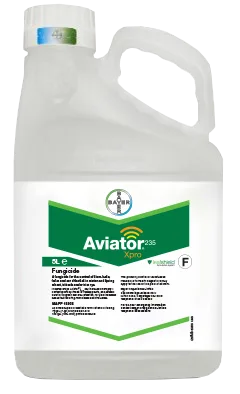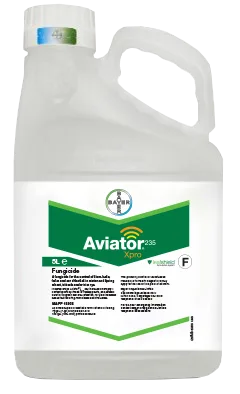

Aviator 235Xpro
Aviator 235Xpro is a one-pack fungicide product containing the SDHI bixafen and class-leading azole prothioconazole.
Product details
The primary goal when applying a T1 fungicide is to control Septoria on the recently emerged final leaf 3 and leaf 4 at GS 31-32.
Timing is critical, with T1 sprays applied too early usually resulting in poor disease control on the emerging leaf 3 due to a lack of coverage on the leaf that emerges after application.
Optimum performance from T1 applications is seen after a T0 spray, typically applied two to four weeks before T1.
When T1 applications are applied too late, leaf 3 is exposed to infection risk for longer. This requires any fungicide to work harder to control latent Septoria when it is eventually applied and can have a negative impact on product efficacy.
1.0 L/ha Aviator 235Xpro + 500g/ha CTL
Where disease pressure is higher, spot-on T1 timing cannot be guaranteed, or the T1 has been delayed, extra Septoria curative activity will be required and the addition of SDHI bixafen in Aviator 235Xpro will boost control, while also giving a physiological boost through crop greening.
Aviator 235Xpro is also formulated with Leafshield technology, which uses a unique combination of adjuvants to improve crop coverage, leaf penetration and movement of the active ingredients within the cereal leaf.
Great coverage potential gives flexibility and confidence when using different application techniques, such as air induction nozzles or a lower water volume. It is also rainfast within minutes, providing consistent performance in challenging spraying conditions.
0.55 L/ha Proline 275+ 500g/ha CTL
While declining azole activity against Septoria has been well documented, primary azole prothioconazole still provides good control of the disease – particularly when applied in a protectant situation with multisite CTL.
In a low disease risk scenario following a robust T0 and where spot on T1 timing can be achieved, 0.55 L/ha Proline275 + 500g/ha CTL provides good control of Septoria, yellow rust, mildew, true eyespot and early season Fusarium and Microdochium inoculum.
A late-sown variety with a good Septoria resistance rating of 7 on the AHDB Recommended List constitutes a low pressure situation in average conditions.
If yellow rust has escaped the T0 timing and is active in the crop at T1, add a strobilurin to 0.55 L/ha Proline275 + 500g/ha CTL to boost rust knock down.
In more susceptible varieties (Septoria rating <7), where the T1 application is delayed, or in high early Septoria pressure seasons, substitute Proline275+ CTL with Aviator235Xpro + CTL for added disease control provided by its SDHI component, bixafen.
The curative efficacy of SDHIs has been slipping over a number of years due to increasing resistance, so teaming a SDHI fungicide with an effective azole such as prothioconazole can support control of Septoria and other disease, alongside good resistance management.
In addition, prothioconazole is tried and tested on eyespot and when combined with bixafen in Aviator235Xpro is boosted to control levels that supersede Tracker.
Fusarium, mildew and yellow rust can also threaten at T1, which is where the robust 80% dose of prothioconazole in Aviator235Xpro makes it a logical choice at T1 because of its strength on all those diseases.
In low disease pressure situations, Aviator235Xpro at 0.8 – 1 L/ha is an excellent choice of fungicide at T1. Low pressure situations occur when the variety has a Septoria resistance rating of 7 or higher, and the crop was drilled in November or later.
In higher risk situations, growers should consider Ascra.
As well as providing good disease control, Aviator 235Xpro also gives a physiological boost through crop greening. Formulated with Leafshield technology, Aviator 235Xpro achieves excellent leaf penetration and movement of the active ingredients within the plant leaf.
Great coverage potential gives flexibility and confidence when using different application techniques, such as air induction nozzles or a lower water volume. It is also rainfast within minutes, providing consistent performance in challenging spraying conditions.
Benefits of Aviator
Aviator offers a robust alternative to single-active fungicides to protect oilseed rape from key diseases, including Phoma stem canker, light leaf spot and mildew, in the autumn and winter, and Sclerotinia at flowering.At the recommended 0.75 L/ha rate, Aviator delivers approximately the same amount of prothioconazole as Proline at 0.46 L/ha, but with the added benefits to disease control and crop physiology from the SDHI bixafen.In trials, compared to Proline alone, the addition of Aviator to fungicide programmes delivered increased curativity and persistency and a yield uplift.With two modes of action, Aviator offers excellent resistance management compared with straight Proline. Aviator also benefits from Bayer's patented Leafshield formulation system which improves spreading, penetration and drying. Originally developed in cereals, Leafshield has notable advantages on the waxy leaves of oilseed rape, by improving rain fastness and coverage.A maximum of two applications of Aviator can be made to the crop, at maximum 1 l/ha rate. This allows both an autumn and spring spray, giving excellent protection to the crop over the highest risk period.
Disease control at flowering
Improved disease control and yield protection at flowering
Controlling Sclerotinia stem rot demands robust protectant fungicides and good timing to protect petals throughout the flowering period.In severe cases Sclerotinia can cause up to 50% yield loss, though the impact may vary year-to-year and between sites. Other diseases, including light leaf spot, are also present at flowering and need to be controlled.Fungicides only provide protection from future infection, and offer no curative activity. This means that spray timings must be optimised to protect the crop throughout the flowering period, and prevent infected petals falling and sticking to leaves.Aviator provides the most effective control of Sclerotinia and light leaf spot, plus useful effects against powdery mildew and Alternaria. In 20 on-farm comparison trials during 2019 and 2020, 85% of growers saw an average 0.18 t/ha yield advantage from using 0.75 L/ha Aviator at flowering.When used at the recommended rate of 0.75 L/ha, Aviator delivers approximately the same amount of prothioconazole as Proline at 0.46 L/ha, but with the added benefits to disease control and crop physiology from the SDHI bixafen. With two modes of action, Aviator is also good for resistance management compared with straight Proline.Aviator also benefits from Bayer's patented Leafshield formulation system. This improves spreading, penetration and drying, and offers notable advantages when applied to the waxy leaves of oilseed rape.The optimum timing for the first spray with Aviator is just before mid-flowering, before the first petals fall. A single application will provide around three weeks of protection, which may be sufficient in some years, and for some sites. However, if flowering is prolonged, the disease risk is very high, or there is a history of severe outbreaks on farm, this can be followed with a second spray three weeks later.

“We gained 0.2 t/ha above the farm standard programme. Financially that’s quite a big gain. On the current prices of oilseed rape, it equates to roughly £70/ha in favour of using Aviator.”